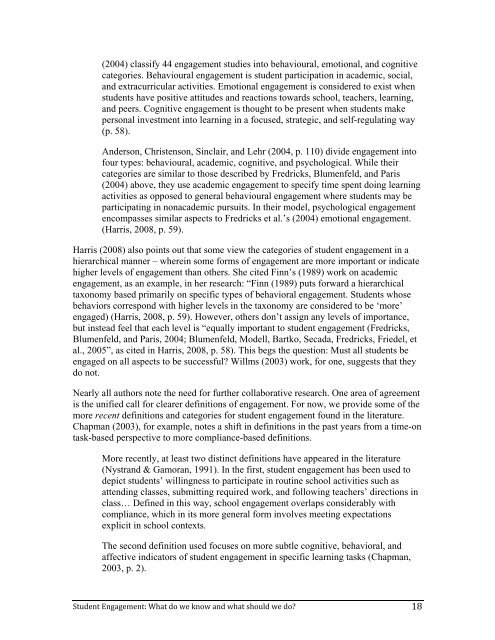Student Engagement: What do we know and what should we do?
Student Engagement: What do we know and what should we do?
Student Engagement: What do we know and what should we do?
You also want an ePaper? Increase the reach of your titles
YUMPU automatically turns print PDFs into web optimized ePapers that Google loves.
(2004) classify 44 engagement studies into behavioural, emotional, <strong>and</strong> cognitive<br />
categories. Behavioural engagement is student participation in academic, social,<br />
<strong>and</strong> extracurricular activities. Emotional engagement is considered to exist when<br />
students have positive attitudes <strong>and</strong> reactions towards school, teachers, learning,<br />
<strong>and</strong> peers. Cognitive engagement is thought to be present when students make<br />
personal investment into learning in a focused, strategic, <strong>and</strong> self-regulating way<br />
(p. 58).<br />
Anderson, Christenson, Sinclair, <strong>and</strong> Lehr (2004, p. 110) divide engagement into<br />
four types: behavioural, academic, cognitive, <strong>and</strong> psychological. While their<br />
categories are similar to those described by Fredricks, Blumenfeld, <strong>and</strong> Paris<br />
(2004) above, they use academic engagement to specify time spent <strong>do</strong>ing learning<br />
activities as opposed to general behavioural engagement where students may be<br />
participating in nonacademic pursuits. In their model, psychological engagement<br />
encompasses similar aspects to Fredricks et al.’s (2004) emotional engagement.<br />
(Harris, 2008, p. 59).<br />
Harris (2008) also points out that some view the categories of student engagement in a<br />
hierarchical manner – wherein some forms of engagement are more important or indicate<br />
higher levels of engagement than others. She cited Finn’s (1989) work on academic<br />
engagement, as an example, in her research: “Finn (1989) puts forward a hierarchical<br />
taxonomy based primarily on specific types of behavioral engagement. <strong>Student</strong>s whose<br />
behaviors correspond with higher levels in the taxonomy are considered to be ‘more’<br />
engaged) (Harris, 2008, p. 59). Ho<strong>we</strong>ver, others <strong>do</strong>n’t assign any levels of importance,<br />
but instead feel that each level is “equally important to student engagement (Fredricks,<br />
Blumenfeld, <strong>and</strong> Paris, 2004; Blumenfeld, Modell, Bartko, Secada, Fredricks, Friedel, et<br />
al., 2005”, as cited in Harris, 2008, p. 58). This begs the question: Must all students be<br />
engaged on all aspects to be successful? Willms (2003) work, for one, suggests that they<br />
<strong>do</strong> not.<br />
Nearly all authors note the need for further collaborative research. One area of agreement<br />
is the unified call for clearer definitions of engagement. For now, <strong>we</strong> provide some of the<br />
more recent definitions <strong>and</strong> categories for student engagement found in the literature.<br />
Chapman (2003), for example, notes a shift in definitions in the past years from a time-on<br />
task-based perspective to more compliance-based definitions.<br />
More recently, at least two distinct definitions have appeared in the literature<br />
(Nystr<strong>and</strong> & Gamoran, 1991). In the first, student engagement has been used to<br />
depict students’ willingness to participate in routine school activities such as<br />
attending classes, submitting required work, <strong>and</strong> following teachers’ directions in<br />
class… Defined in this way, school engagement overlaps considerably with<br />
compliance, which in its more general form involves meeting expectations<br />
explicit in school contexts.<br />
The second definition used focuses on more subtle cognitive, behavioral, <strong>and</strong><br />
affective indicators of student engagement in specific learning tasks (Chapman,<br />
2003, p. 2).<br />
<strong>Student</strong> <strong>Engagement</strong>: <strong>What</strong> <strong>do</strong> <strong>we</strong> <strong>know</strong> <strong>and</strong> <strong>what</strong> <strong>should</strong> <strong>we</strong> <strong>do</strong>? 18












